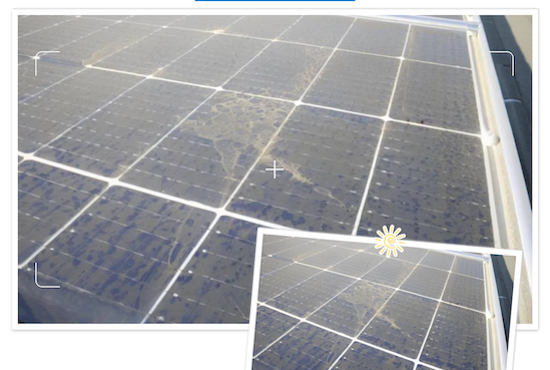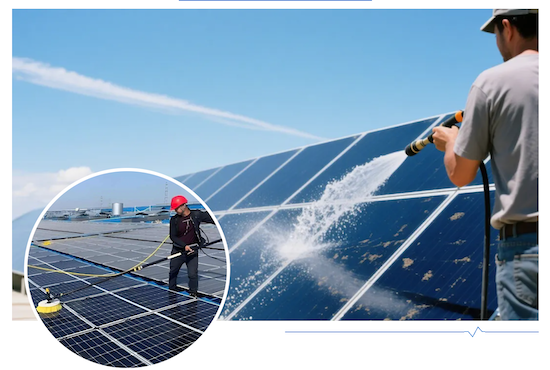
media coverage
Driven by the national “dual carbon” targets, photovoltaic (PV) power generation has advanced from being a supplementary energy source to becoming one of the main pillars of the energy system. The pace of technological iteration, along with the refinement of operation and maintenance practices, directly shapes the quality and sustainability of the renewable energy industry. However, within the operation of solar power plants, the seemingly minor task of cleaning and upkeep is often overshadowed by more prominent indicators such as panel conversion efficiency or inverter performance. In fact, surface contamination does far more than simply reduce power output; it critically affects whether a solar installation can truly achieve its intended service life. The value of professional PV cleaning agents lies in their ability to fundamentally prevent such hidden degradation.
Invisible Yet Influential - Contaminants on Solar Panels

Contaminants onthe surface of photovoltaic (PV) panels are never merely inert “coverings”; rather, they act as latent sources of cascading risks. In regions prone to wind and sand, dust accumulation on panel surfaces can reach 0.3 mm per week. This seemingly thin layer can reduce transmittance by 15–20%, effectively “swallowing” one-fifth of each module’s output capacity. Even more concerning is the localized shading caused by bird droppings or fallen leaves, which can trigger the so-calledhot-spot effect. In this process, the shaded area functions as a load, driving local temperatures sharply upward. The result is not only accelerated cell degradation but also irreversible damage such as encapsulant discoloration and backsheet cracking.
In industrially dense regions, pollutants such as acid–alkaline mists and oil residues pose more insidious threats. Through rainfall infiltration, these substances can attack the oxide layer of aluminum alloy frames, leading to corrosion. Meanwhile, oil residues disrupt the anti-reflective coating on the glass surface, causing reflectivity to increase from around 3% to more than 10%.
Industry data from 2025 indicate that uncleaned PV panels suffer an average annual efficiency loss of 15–25%, which, for a 10 MW power plant, equates to an estimated revenue reduction of about 200,000 RMB per year. Dust, bird droppings, and industrial pollutants adhering to module surfaces are, in effect, eroding investors’ profits in the most inconspicuous manner.
Beyond Common Assumptions - The Technology of PV Cleaning
The technical requirements for cleaning photovoltaic (PV) panels are substantially higher than the simplistic notion of merely “rinsing with water or generic detergents.” Simple water rinsing has been shown to be largely ineffective, whereas high-pressure water cleaning, despite its apparent efficiency, introduces potential risks. Pressures exceeding 0.5 MPa can induce micro-cracks in the glass surface and may drive contaminants lodged within frame gaps further inward, thereby accelerating module water ingress. Moreover, the use of conventional cleaning agents presents challenges related to uncontrolled pH levels; certain products exhibit pH values approaching 10, which can corrode the anti-reflective coating on the panel surface and progressively diminish transmittance.
The complexity of PV cleaning becomes even more apparent across different application scenarios. For example, in rooftop distributed PV systems, the installation environment often includes chimneys, air-conditioning units, and other equipment that emit additional oil residues and dust. This increases the heterogeneity of contaminants and significantly raises cleaning difficulty. Improper cleaning practices in such constrained environments may not only fail to remove stains thoroughly but also risk unintentional damage to the panels due to limited operational space.

Specialized Solar Panel Cleaning Solutions - An Emerging Necessity
After years of dedicated research and development, Polymer has introduced the POLYTE®PG Clean series, a high-efficiency cleaning solution specifically formulated for photovoltaic (PV) panels. The product employs a near- neutral formulation, free of heavy metals and salts, enabling rapid dissolution of dust, bird droppings, oil residues, and other contaminants without compromising the integrity of surface coatings or sealants. Its unique penetration and decomposition technology allows the cleaning agents to infiltrate contaminants at the molecular level, ensuring complete detachment from the panel surface for thorough cleaning.
In addition, the POLYTE® PG Clean series incorporates antistatic properties, forming a protective layer on the PV panel surface post-cleaning. This significantly reduces the rate of dust accumulation, effectively prolonging cleaning intervals and lowering operation and maintenance costs. Importantly, the product has been professionally tested and found non-toxic to aquatic organisms, biodegradable, and free from soil contamination, there by meeting environmental standards. By balancing cleaning efficiency with ecological protection, the POLYTE® PG Clean series represents a sustainable solution for PV panel maintenance.
POLYTE® PG Clean 601: White & light yellow liquid,Relative Density 0.98~1.08,Flash Point >100℃, pH(1%) 7~8, for dust cleaning.
POLYTE® PG Clean 602: White & light yellow liquid,Relative Density 1.08~1.18,Flash Point >100℃, pH(1%) 7~8, for bird droppings, colloidal stains, oil, etc. cleaning.
Professional photovoltaic(PV) cleaning agents create three key latent values: preservation of energy output, extension of equipment lifespan, and mitigation of operational risks. They are far more than simple cleaning tools; they serve as critical enablers for the long-term stable operation of solar power plants and the maximization of returns. Selecting a professional cleaning solution represents a strategic investment in the future performance of a PV installation, ensuring that each module can operate at its full potential throughout its lifecycle and contributing to the sustainable development of the renewable energy sector.